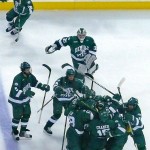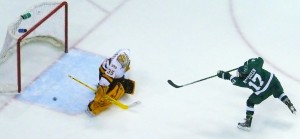Surging Beavers add UMD to WCHA playoff victims

Bemidji State players poured off the bench to celebrate after an overtime goal by Shea Walters of Hibbing beat UMD 3-2.
By John Gilbert
SAINT PAUL, MN. — Shea Walters joked about how it was the biggest goal he had scored all season, and it was. It was also the only goal he’s scored all season. But it was just enough to lift Bemidji State to a 3-2 victory over Minnesota-Duluth in sudden-death overtime Thursday afternoon and continue the Beavers longshot streak through the WCHA playoffs.
Bemidji State finished 10th in the WCHA, and reached the league’s Final Five only by upsetting the league’s No. 3 seed, Nebraska-Omaha, in two games last weekend. Having beaten the No. 3 seed, Bemidji State has now also beaten No. 4 UMD, and sets its sights squarely on No. 2 seed Denver in Friday’s semifinals.
The second semifinal puts league champion North Dakota up against Colorado College, which ended Alaska-Anchorage’s similar longshot bid 4-2 in Thursday night’s game. CC led 2-0 after one period, despite the Seawolves carrying much of the play, then Joe Marciano scored twice in the second period as the lead swelled to 4-1. Marciano had scored only once in his two seasons at CC, before scoring twice against Anchorage. All four Tigers goals deflected in off skates, while goaltender Joe Howe was outstanding for CC.
The second game may have secured an NCAA berth for Colorado College, but it lacked the drama of the first game.
Walters, who used to be a flashy scorer at Hibbing High School, which happens to also be the alma mater of UMD coach Scott Sandelin, plays the point on Bemidji State’s second power-play unit. When UMD defenseman Trent Palm was called for high sticking at 5:53 of the 20-minute overtime, Bemidji State coach Tom Serratore decided to go with the second unit instead of Matt Read’s No. 1 group.
“The Read line was just coming off, and besides, they had given up a short-handed goal,” said Serratore. “And our second unit moves the puck well.”
What they don’t do is score very often. Read moves back from center to play the point on the first unit, which has scored 21 goals this season, while the second unit — in fact, the entire rest of the Beavers lineup — had scored a total of 3 goals all season. But now it’s 4. Ryan Cramer won the left corner faceoff to Dan MacIntyre on the left point, and he slid the puck to Walters, moving toward center point. “We got a big win off the draw, and McIntyre gave me a nice pass. All I wanted to do was get it on net,” said Walters. “I saw it all the way.”
The puck appeared to nick the stick of Justin Fontaine and deflect slightly to the right, eluding goaltender Kenny Reiter and catching the lower right corner of the net. The goal lifts Bemidji State (15-17-5) to the next rung on its ladder of survival. Because of their status, the Beavers could only reach the NCAA field by winning the Final Five with a three-day marathon performance to capture the automatic league slot, but for the 10th-place Beavers to knock off third-place Nebraska-Omaha in a two-game sweep, then fourth-place UMD is an impressive basis for taking on second-place Denver.
“We knew exactly how they’d play,” said Sandelin. “I didn’t think our overall level of play was where we needed it to be.”
Serratore said he didn’t feel as though slowing the game down was the style his team wanted. “We knew it was going to be a tough game,” said Serratore. “We wanted to play with more tempo, but I thought it was a cat and mouse game. When we got that goal early in the third period, it definitely gave us some jump. The overtime was like a soccer match — chip it out, chip it in. It looked like nobody wanted to have the puck. But that’s playoff hockey. It’s tough to get the puck to the net, because you’ve got to defend hard.”
Any advantage Bemidji State might have had by wearing green on St. Patrick’s Day in Saint Paul was offset by UMD’s Irish connection of the unrelated Connolly boys. Jack Connolly took sole possession of the WCHA all-game scoring lead by deflecting in a shot from the left point by Justin Faulk at 6:05 of the first period, staking the Bulldogs to a 1-0 lead.
Bemidji State countered when Brad Hunt moved in from the right point, maneuvered for position, and beat Reiter with a shot into the lower right at 13:27.

UMD's Mike Connolly sprawled after scoring short-handed with a pass from Justin Fontaine for a 2-1 lead against Bemidji State.
UMD regained the lead before the first period ended when Mike Connolly went down to block a pass while killing a penalty, then fed an outlet pass to Justin Fontaine on the right side while joining him for a 2-on-1. Fontaine carried to the right faceoff circle before sending a perfect pass across the slot, where Mike Connolly gathered it in and crossed the goal-mouth right to left to slide backhand under goalie Dan Bakala.
UMD had an 11-7 edge in shots in the first period, but it the scoreless second period saw the game make a transition into Bemidji State’s favored style — tight, tenacious defensive play with very few scoring chances. There were, in fact, no scoring chances worth noting, as UMD outshot Bemidji State 6-5 in the session.
Sure enough, the third period started and Jordan George got the puck behind and to the right of the UMD goal, and passed out to the right circle. Reiter started moving one way, then reached back the other, while Read fired through the moving goalie and scored at 0:28, tying the game 2-2. “It was a great pass from Jordan George,” said Read. “I saw the defenseman and shot and it went in.”
Read, a senior, leads the Beavers with 22 goals — the same total as the nine players on the second, third and fourth Beaver lines. His wingers, Jordan George (16 goals) and Ian Lowe (12), mean the top line has 50 goals, out of Bemidji State’s team total of 87. But that doesn’t mean the entire Beaver lineup doesn’t contribute with great intensity.
UMD defenseman Mike Montgomery said: “We knew exactly how they’d play, looking for bounces in the neutral zone and wait for their chances. We just didn’t play our game. Our goal was to try to get another goal when the third period started and try to get some separation. Instead, they got it. They work harder than anybody, so I don’t see why they can’t keep it going.”
The Beavers went on to outshoot UMD 8-5 in the period, but both goaltenders kept the 2-2 tie intact. Reiter had more pressure, particularly when Jamie MacQueen broke in on him with 4:29 remaining. Defenseman Trent Palm dived to try to catch MacQueen, and took his feet out from under him. The officials called for a penalty shot, which was high drama with 4:29 remaining in a 2-2 tie game. MacQueen skated in and made his bid, but Reiter got his right leg pad out just in time to deflect the shot wide of the left post.
UMD came up with its three or four best chances in the final minute of regulation, and even in the final 10 seconds, before the Beavers iced the puck hard with two seconds remaining. However, the officials didn’t call icing and let the closing seconds tick off. Referee supervisor Greg Shepherd explained that the new WCHA rule requires a defending player to skate back for the iced puck as far as the faceoff spots before the officials can call icing.
“I played against that Connolly line all game,” said Read, whose defense was as important as his goal. “I know how dangerous they are. They hemmed us into our end for the whole last minute-ten. But we worked all week on staying on our guys.”
The Beavers got the game into overtime, where one play could win the game, and it actually took two. First, a Beaver forechecker ducked under Lamb’s arm to swipe the puck, and when he went down, Lamb’s stick caught him up high, and Lamb was called for high sticking. Clever move for the Beavers, unfortunate call for the Bulldogs, because it gave the Beavers a fortuitous power play, and Walters made it count.
“If we lose, we’re done,” said Read. “We know we’re the underdogs, we’ve just got to keep it going.”
On the other side, UMD can keep practicing, and probably has a high enough rank to be picked among the NCAA’s 16-team field next week. “This team has responded well all season,” Sandelin said.”I told them to remember how losing feels. Because it sucks!”
Comments
Tell me what you're thinking...
and oh, if you want a pic to show with your comment, go get a gravatar!



 John Gilbert is a lifetime Minnesotan and career journalist, specializing in cars and sports during and since spending 30 years at the Minneapolis Tribune, now the Star Tribune. More recently, he has continued translating the high-tech world of autos and sharing his passionate insights as a freelance writer/photographer/broadcaster. A member of the prestigious North American Car and Truck of the Year jury since 1993. John can be heard Monday-Friday from 9-11am on 610 KDAL(www.kdal610.com) on the "John Gilbert Show," and writes a column in the Duluth Reader.
John Gilbert is a lifetime Minnesotan and career journalist, specializing in cars and sports during and since spending 30 years at the Minneapolis Tribune, now the Star Tribune. More recently, he has continued translating the high-tech world of autos and sharing his passionate insights as a freelance writer/photographer/broadcaster. A member of the prestigious North American Car and Truck of the Year jury since 1993. John can be heard Monday-Friday from 9-11am on 610 KDAL(www.kdal610.com) on the "John Gilbert Show," and writes a column in the Duluth Reader.